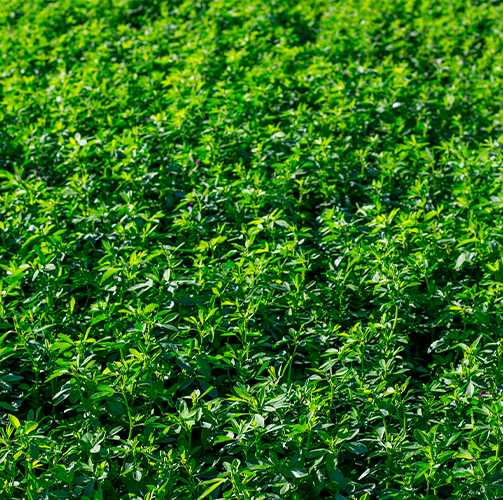Looking After Lucerne
Here are some handy tips for preparing, planting and managing lucerne.
For the New
Plan well in advance when considering planting a lucerne stand. Two years out is ideal. Key things to consider are;
- Soil type – needs free draining soil.
- Fertility – soil test done, pH over 6.2.
- Existing weed burden – some weeds cannot be controlled in lucerne so reducing the weed burden prior to sowing is very important.
- Will it fit my farm system (winter dormancy, stock policy…)?
We normally advise spring sowing wherever possible. Important points are:
- Select a cultivar that is right for your farm system. Cultivars are categorised by their winter dormancy. A dormancy of 4 or 5 seems to suit most conditions in New Zealand.
- Make sure the seed has been inoculated. Lucerne requires specific viable rhizobia for nodulation and nitrogen fixation.
- Soil temperature is important at sowing, 10°C and rising, the seeds need to germinate quickly to better compete with any germinating weeds.
- Apply fertiliser at sowing. Phosphorous is a vital element for the crop.
- A pre-emergence herbicide can be applied, this needs to be soil incorporated (shallow).
- The seed bed must be fine and firm, to allow good emergence and establishment.
- A post-emergence herbicide can be applied four to six weeks after germination as well as a nitrogen side dressing. Lucerne will not start fixing nitrogen for at least six months.
- Allow the new lucerne to grow for approximately four months or when it has flowered at least 50%. This will allow the lucerne to develop a deep taproot thereby gaining access to resources (water and nutrients) which most other forage plants are unable to exploit.
- At this time graze the sward or harvest mechanically.
- If mechanically harvesting replace the nutrient removed from the system with a fertiliser application.
Winter weed control is important to keep the lucerne stand as weed free as possible. New (young) lucerne requires softer chemistry compared to older stands. All these points are key to achieving a high performing longstanding lucerne sward.
For the Old
In late summer and during autumn lucerne stands need resting to allow flower development (prolonged rest). This stimulates the plant to send carbohydrate reserves to the extensive root mass, giving the plant energy to draw off for the early spring growth.
The winter dormancy period is our chance to get rid of any competition in the ground. Prior to the identification of the unwanted plants in our sward, we recommend grazing the stand as short as possible to allow the appropriate sprays to act on those unwanted weeds while not affecting the viability of the lucerne stand.
It is important that any feed shortage in the feed budget created by the dormancy of the lucerne, is covered with other sources of protein, fibre and carbohydrates in the farm system.
Lucerne leaves grow from the tip of the stem, therefore are stimulated by air temp rather than soil temperature. When removed during cutting or grazing it stimulates new stems growing from the base of the plant (crown).
A robust fertiliser program is key to maximising seasonal production. Starting with a maintenance application in early spring prior to harvest. This should include macro and micro elements.
If the lucerne sward is mechanically harvested, we recommend replacing the mined nutrients after each cut based on the amount harvested. Under a grazing situation this is not limiting as some nutrients are returned to the soil via excretion.
Cutting/grazing time is determined by the development of the basal buds rather than the above ground biomass. To optimise and harvest the best quality lucerne the ideal harvest height is 300mm (3 tonnes of biomass/ha). This is to maintain the MJME at 11.5-12. If leaving to graze longer we will have more stem with a lower quality of MJME 8.
In late spring and summer, harvest period can be between 30-42 days depending on the region and time of the year. Cutting or grazing too early will reduce regrowth of the new stems.
As mentioned earlier, rest the lucerne in late summer/early autumn to restore mined energy. Growth rates slow down during the autumn due to the cooling air temperature. Five quality harvests of lucerne can be achieved in a season with a combined yield over 14T DM/ha of high in-protein feed.
Important points to remember:
- Lucerne has no requirement for salt therefore supplementing with salt blocks when grazing is recommended.
- Under a grazing situation, duration of less than 7-10 days is recommended. Set stocking is not advisable. Lucerne can cause bloat in cattle – bloat control is important.
- Fungi can cause fertility issues in sheep if being grazed during mating.
- Aphids in spring can be an issue.



